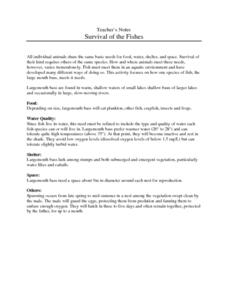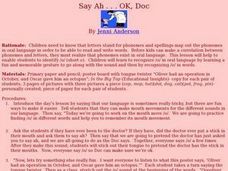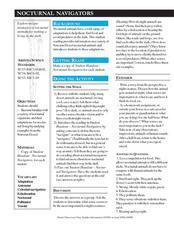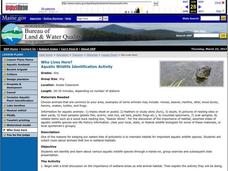Curated OER
Judaism-Passover: What is Passover?
In this Judaism worksheet, students determine where the 12 words or phrases in the word bank belong in the short narrative about Passover.
Curated OER
Historic Leaders- Word Scramble Worksheet
In this historic leaders word scramble worksheet, learners use the names in the word bank at the bottom of the page to assist them with the word scramble. They unscramble names which include Genghis Khan, Cleopatra, Queen Victoria, and...
Curated OER
Tudor Homes- The Still Room and Herb Garden
In this Tudor homes worksheet, students read about the importance of the still room and the herb garden in Tudor life. They locate and identify herbs, sketch a plan of a herb garden at Blakesley Hall, draw an herb, and locate a recipe...
Curated OER
Letter Ff Pictures
In this letter and word recognition worksheet, students study the various images and color the pictures that start with the letter F. Students color the images of the feather, fence, frog, flag, fish, flamingo, foot, fire, and football.
Curated OER
Drawing Conclusions and Comparing/Contrasting - The Everglades
Students complete activities to compare, contrast, and draw conclusions for a lesson about the Florida Everglades. In this drawing conclusions lesson, students watch videos about a scientists study of pig frogs that live in the Florida...
Curated OER
NFE General Knowledge Quiz
Eighth graders review various aspects of World History. For this World History lesson, 8th graders participate in a bingo game. Students complete a worksheet during bingo.
Curated OER
Word Recognition
In this word recognition worksheet, students read the sentences and study the pictures that correspond. Students circle the sentence that illustrates the image in the picture. Students complete 5 examples.
Curated OER
"Open Your Mouth and Say AH!"
Students practice letter and sound recognition of the vowel o=/o/. They study the tongue twister "Tom got a frog from the pond" and the book, "If You Give a Moose a Muffin," by Laura Joffe Numeroff with an accompanying worksheet to master.
Curated OER
Managing the Teaching-Learning Process
Twelfth graders begin to recognize how 2,400 year-old dramas are applicable to their lives after reading OEDIPUS THE KING, AGAMEMNON, ANTIGONE, MEDEA, HIPPOLYTUS, and FROGS.
Curated OER
Green Worksheet
In this color recognition instructional activity, students study the various images and color the pictures of things that can be green. Students color the pictures of the frog, bell pepper, crayon, turtle, alligator, and pear.
Curated OER
Zebra, Zebra Where Are Your Stripes?
Young scholars observe the embryological development in the zebrafish. Developmental hierarchy from three germ layers is studied in depth. Research is validated on the body plan of the embryo.
Curated OER
Paper
Students study the process of creating paper. They read and discuss a flier and visit centers in small groups to study Paper Fun, Historical Paper, What Paper Is Made Of, and Homemade Paper. After visiting each center, they share the...
Curated OER
DID YOU HELP CREATE THIS
Pupils examine whether their actions are positively or negatively affecting organisms and their habitats. They choose an animal to study then create a multimedia presentation including charts and graphs of data logger information and...
Curated OER
Survival of the Fishes
Students study the aquatic environment in which largemouth bass are able to survive. They participate in a mystery animal activity based on their own basic needs to determine the identity of the largemouth bass.
Curated OER
I Love to Eat Apples!
Learners study the a=/a/ correspondence by first examining how they hold their mouths when biting into an apple. They practice the sound while reciting a tongue twister and making a gesture each time they hear the /a/. While looking at...
Curated OER
Say Ah . . . OK, Doc
Learners distinguish between letters that stand for phonemes that deal with the short /o/ sound. They study how spellings map out the phonemes in oral language in order to be able to read and write words. Each student practices the...
Curated OER
Aaa-aaa-aaa-choo!!
Students study the /a/ sound by mimicking the sound one makes when they sneeze. Next they work with a tongue twister, which they recite while stretching out the initial short a sound. Next, they practice writing the letter and read "A...
Curated OER
Barn Owl
In this barn owl worksheet, students read four paragraphs of information about barn owls, and study a photograph. There are no questions here.
Curated OER
Human Features of Our Community
Students investigate the human factors that create a community. They conduct research using a variety of sources. Students then create dioramas that depict a typical scene found in a community.
Curated OER
Open Wide at the Dentist, "Aaaahh"
Study the /o/ in both written and spoken words by reciting a tongue twister and making words using Elkonin letterboxes. Next, write a message about frogs using /o/ words. Finally, listen to a short book talk on "Doc in the Fog" before...
Curated OER
The Banana Doesn't Fall Far From the Tree!
Young scholars research their family history and make a family tree. In this family tree lesson plan, students are given an example of a family tree with names, pictures, and descriptions of each person. They then are instructed to...
Curated OER
Amphibians Internet Activity
In this amphibians worksheet, students click on the links in the questions about amphibians to find the answers to the questions and then come back and answer the questions. Students answer 10 questions total.
Desert Discoveries
Nocturnal Navigators
Young biologists take a look at some of the unique ways that nocturnal animals survive in the dark. After reading a terrific student handout which is embedded in the plan, learners work together to answer questions about what they have...
Curated OER
Who Lives Here?
Students identify various aquatic wildlife species. In this biology lesson students collect clues about animals that live in wetland habitats. Students rotate through several stations displaying particular animal species to collect their...

























